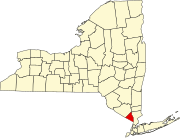Hillcrest, New York | |
|---|---|
 Hillcrest Fire Company No. 1 station | |
 Location in Rockland County and the state of New York. | |
| Coordinates: 41°7′47″N74°2′8″W / 41.12972°N 74.03556°W | |
| Country | United States |
| State | New York |
| County | Rockland |
| Town | Ramapo |
| Area | |
• Total | 1.30 sq mi (3.38 km2) |
| • Land | 1.30 sq mi (3.38 km2) |
| • Water | 0.00 sq mi (0.00 km2) |
| Elevation | 512 ft (156 m) |
| Population (2020) | |
• Total | 8,164 |
| • Density | 6,255.94/sq mi (2,415.46/km2) |
| Time zone | UTC-5 (Eastern (EST)) |
| • Summer (DST) | UTC-4 (EDT) |
| FIPS code | 36-34693 |
| GNIS feature ID | 0952813 |
Hillcrest is a hamlet incorporated in 1893 and census-designated place, in the town of Ramapo, Rockland County, New York, United States. It is located north of Spring Valley, east of Viola, south of New Square and New Hempstead, and west of New City. The population was 8,164 at the 2020 census. [2]
Contents
It is a bedroom suburb of New York City, as many residents commute to employment in Manhattan (and, to a lesser extent, northern New Jersey) by bus (Red and Tan Lines), train (Metro-North Railroad) or automobile.[ citation needed ] It is primarily served by the Spring Valley post office.

